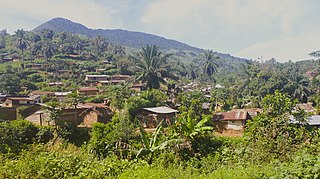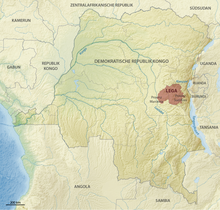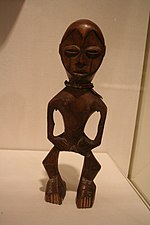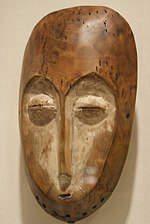
South Kivu is one of 26 provinces of the Democratic Republic of the Congo (DRC). Its capital is Bukavu.

The Ulindi River is a tributary of the Lualaba River in the Democratic Republic of the Congo (DRC). There is a proposal to build a hydroelectric power plant on the river to power a gold mining project.

The culture of the Democratic Republic of the Congo is extremely varied, reflecting the great diversity and different customs which exist in the country. Congolese culture combines the influence of tradition to the region, but also combines influences from abroad which arrived during the era of colonization and continue to have a strong influence, without destroying the individuality of many tribal customs.

Masisi Territory is a territory which is located within the North Kivu Province of the Democratic Republic of the Congo. Its political headquarters are located in the town of Masisi.

Walikale Territory is a territory located within the Congolese province of North Kivu, in the eastern regions of the Democratic Republic of the Congo. The headquarters are in the town of Walikale. The locality is situated between Bukavu and Lubutu on DR Congo National Road No. 3 in the valley of the river Lowa, 135 km to the west of Goma.

Shabunda is a town and a territory of South Kivu in the Democratic Republic of the Congo. Shabunda is the largest territory in the province, covering more than 25,000 square kilometres.

WalunguTerritory is a territory located within the South Kivu Province in the eastern part of the Democratic Republic of the Congo (DRC). Situated approximately 40 km from Bukavu, the capital of South Kivu Province, it shares borders with Kabare Territory to the north, Mwenga Territory to the south, Uvira Territory and the Ruzizi River, as well as the Republics of Rwanda and Burundi to the east, and Shabunda Territory and part of Kabare Territory to the west. According to the 2018 national census, the region has a population of 716,671, with 672,436 residing in the Ngweshe Chiefdom and 44,235 in the Kaziba Chiefdom. Spanning an area of 1,800 km2, Walungu Territory has a population density of 398 inhabitants per square kilometer.
Daniel P. Biebuyck was a Belgian scholar of Central African art.

The provinces of the Democratic Republic of the Congo were divided into 26 districts. Those in turn were divided into territories or communes.
The Elila River is a tributary of the Lualaba River in the Democratic Republic of the Congo. It rises in Mwenga Territory of Sud-Kivu Province and flows west through Shabunda Territory and then Pangi Territory in Maniema Province, entering the Lualaba just downstream of Kindu.
Pangi Territory is an administrative area in Maniema Province of the Democratic Republic of the Congo. The headquarters is the town of Pangi.
Kalehe Territory is a territory in South Kivu, Democratic Republic of the Congo. Its administrative centre is the town of Kalehe on the western shore of Lake Kivu. Other important towns include Buguli, Bunyakiri, Kalangala, Kalungu, Minova, and Nyamasasa.

The Districts of the Belgian Congo were the primary administrative divisions when Belgium annexed the Congo Free State in 1908, each administered by a district commissioner. In 1914 they were distributed among four large provinces, with some boundary changes. In 1933 the provinces were restructured into six, again with boundary changes. The number of districts fluctuated between 12 and 26 through splits and consolidations, first rising, then falling, then rising again.
Kayuyu is a settlement in Maniema province, Democratic Republic of the Congo.

Kasika is a village located in the Luindi Chiefdom within the Mwenga Territory of the South Kivu Province, situated in the eastern region of the Democratic Republic of the Congo (DRC). Geographically positioned at 965 meters above sea level, Kasika strategically lies near Kihovu and Kahulile, approximately 108 kilometers from Bukavu, near the Rwandan border. The region is more than clusters of mud huts built around a Catholic parish on a hill overlooking a valley. It was the headquarters of the customary chief of the Nyindu ethnic community, whose house and office sat on a hill opposite the parish, a series of large, red-brick structures with cracked ceramic shingles as roofing, laced with vines.
Kaniola Groupement, also known as Kanyola, is one of the 16 groupements (groupings) that constitute the Ngweshe Chiefdom of the Shi people. Kaniola Groupement is located at an elevation of 1800 meters and is situated 64 km from Bukavu city. It shares borders with the Kahuzi-Biéga National Park and the Nindja Chiefdom to the northeast, while being bordered by the Izege groupement and Walungu groupement to the east. It is also bordered by the Burhale groupement and Mulamba groupement in the west.

Mutambala is a sector that constitutes one of the four sectors in the Fizi Territory of the South Kivu Province in the eastern part of the Democratic Republic of the Congo. Mutambala is situated near Lake Tanganyika, in the west by the Lulenge sector, in the north by the Tangani'a sector, and in the south by the Ngandja sector. It has a surface area of 777 km 2. The sector consists of five groupings (groupements), including the Basimukindja groupings, the Batombwe groupings, and the Babwari groupings.

The Nyindu people, are an ethnic group predominantly found along the Ulindi River in the north, west, and south, as well as the Kilungutwe River, located in the Mwenga Territory in the southern part of South Kivu Province in the eastern region of the Democratic Republic of the Congo (DRC). The Nyindu people belong to the Bantu ethnic group and linguistic family, which is among the most populous and diverse ethnic groups in the South Kivu Province. They are known for their traditional agricultural practices, which include cultivating crops such as maize, cassava, and beans. They also engage in animal husbandry, particularly with cattle. The Nyindu are organized into clans, and each clan has a chief who serves as a leader and arbitrator.
The Kilungutwe River is a watercourse located in the Mwenga Territory of the South Kivu Province, situated in the eastern part of the Democratic Republic of the Congo (DRC). With an elevation of 882 meters, it functions as a tributary to the Ulindi River. Following the confluence with the Ulindi River approximately 30 km northwest, the Ulindi River proceeds on its course, eventually joining the Congo River. The Kilungutwe River was historically known as the gateway to the jungle from the highlands to the northeast.
The Luindi Chiefdom, also known as Lwindi Chiefdom, is a chiefdom located in the Mwenga Territory of the South Kivu Province in the eastern region of the Democratic Republic of the Congo (DRC). It is situated in the mountainous area of the Itombwe Massif, which is known for its rich biodiversity and unique wildlife.

















